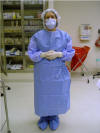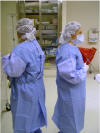|
Operating Room Conventions |
The Operating Room is a critical care area with tightly regulated rules, both formal and informal. To effectively and safely function in this environment, it is important for you to have a good familiarity with these rules.
OR Personnel: Every OR has a circulator, or circulating nurse. This nurse is in charge of the room and its' equipment. If something special is needed, she gets it. He or she supervises setting up the room and cleaning it at the end of the case. The circulator will ask your name, take your pager if you are scrubbing in, and track your glove size. Any questions involving OR protocol are best directed to the circulator.
For major surgical cases and some minor cases, there will be a scrub nurse or scrub tech. This individual will be dressed in a sterile gown and gloves, and is responsible primarily for organizing the surgical instruments and passing them to the surgeon. Sometimes, this person also assists with the surgery. The scrub nurse (or tech) has a sterile tray on a stand, called the "Mayo Stand." On the tray are the instruments that may be immediately needed by the surgeon. Don't touch the Mayo Stand.
- Don't pick things up off the Mayo Stand...ask for them.
- Don't put things down on the Mayo Stand...hand them to the Scrub Nurse.
- Even after the case is over and the patient is waking up from anesthesia, don't touch the Mayo Stand...it needs to remain sterile in the event there are problems with the anesthesia that could require surgical resolution.
 For all major and many minor surgical cases, an anesthesiologist or
anesthetist will be present. They are primarily responsible for the general
safety of the patient during the procedure. They watch to make sure that no
straps are too tight, and the arms and legs are not being overly stretched.
They monitor vital signs and concurrent lab values (oxygenation, EKG, BP,
pulse, etc.). They remain by the patient's head during the procedure, with
their equipment. Don't touch the anesthesia equipment.
For all major and many minor surgical cases, an anesthesiologist or
anesthetist will be present. They are primarily responsible for the general
safety of the patient during the procedure. They watch to make sure that no
straps are too tight, and the arms and legs are not being overly stretched.
They monitor vital signs and concurrent lab values (oxygenation, EKG, BP,
pulse, etc.). They remain by the patient's head during the procedure, with
their equipment. Don't touch the anesthesia equipment.
- Anesthesia personnel take their jobs very seriously and are control-oriented. If you touch their equipment, they will be troubled, for fear that you may have inadvertently changed some setting or monitoring parameter.
- If you accidentally touch the equipment, tell the anesthetist about it immediately (in a contrite tone of voice), and they will check to make sure you didn't change any settings.
Attire: A clean scrub suit is necessary whenever
you enter an operating room or the corridors leading to the OR. These
corridors are considered clean and street clothing is not permitted. Scrub
suits are found in the dressing rooms adjacent to the Operating Room suite.
 You will need a surgical cap that covers your head hair. All loose hair
should be tucked in. You will also need shoe covers that completely cover
your shoes. These disposable items can be found in the dressing rooms.
You will need a surgical cap that covers your head hair. All loose hair
should be tucked in. You will also need shoe covers that completely cover
your shoes. These disposable items can be found in the dressing rooms.
Before entering the OR itself, you will need to wear a surgical mask. These come in many forms, but all accomplish the same purpose, trapping the fine aerosol that contains bacteria whenever you exhale, speak, cough, or sneeze, preventing contamination of the surgical wound. Most masks has a thin metal strip at the top that is designed to conform to the shape of your nose. After putting the mask on, make sure you mold the metal strip to fit you well. Many masks have transparent splash shields to prevent body fluids from inadvertently splashing into your eyes. If you are not wearing safety glasses or goggles, you will need a splash shield. If you wear glasses during surgery, consider plastic side panels to prevent splash from the sides.
Where to stand: You can stand anywhere that you are not in the way of the others in the OR.
Usually, good places to
stand include a step behind the surgeon or assistants, or at the head
of the surgical table next to the anesthesiologist. Don't stand at the head
of the table during the anesthesia induction...wait until the patient is
fully anesthetized and the anesthesiologist has settled into routine
monitoring. Then ask the anesthesiologist if you can stand at the head of
the table to watch the surgery.
Sometimes it is useful to use a "step" to be higher. Ask the circulating
nurse (the nurse who is not scrubbed-in), if you can have a step or
platform.
If you are scrubbed-in, ask the surgeon where you should stand before moving up to the operative field.

|
What you can touch: You will either be scrubbed-in or not scrubbed-in. This status determines what you can and cannot touch. If you are not scrubbed-in, you cannot touch anything sterile. This includes the surgical gowns, drapes, gloves, equipment, and any side tables that are covered with sterile (usually blue or green) surgical drapes. When I am in the OR and not scrubbed-in, I usually clasp my hands together behind my back to remind me not to touch anything sterile. Do not lean over any sterile area. If you accidentally touch something sterile, notify the surgical team right away. They can re-cover the sterile area you touched and proceed uneventfully with surgery, so long as they know about it.
If you are scrubbed-in, then you can only touch sterile items. If you accidentally touch something that is not sterile, tell the surgical team about it right away. They can always get you another sterile glove, so long as they know about it. When I am scrubbed-in, I usually stand with my hands clasped together over my chest, or if I am standing next to the sterile-prepared patient, place my hands on the sterile field.
If you must move to pass another scrubbed-in person, you will pass back to back, so that any inadvertent touching of each other as you pass will occur on your back (not considered sterile) areas.
If you have an itchy nose or ear, you can ask the circulating nurse (who is not scrubbed-in) to scratch it. If you notice your eyeglasses need adjustment, ask the circulator to adjust them.
Talking: Most of the time, you should be listening and watching, not talking. Knowing that you are observing surgery for your education, most surgeons will explain what they are doing and show you important anatomic landmarks. If the surgeon falls silent for a time, it is not usually because they are ignoring you...usually it's because they are focusing on some surgical problem. Remember that the surgeon's primary responsibility is to guide the patient safely through the procedure, and your education, as important as it may seem, is of secondary importance. Feel free to ask questions of the surgical team, but try to avoid critical times to ask your questions (it will be obvious.)
Coughing and Sneezing: If you are ill, you should not be in the OR at all. Sometimes, even if well, the need to cough or a sneeze will sometimes overpower you. If you have time to move completely away from the patient before sneezing or coughing, do that. If you are standing at the patient's side and suddenly must cough or sneeze, look directly at the surgical wound while sneezing. That way, the fine aerosol that is created by the sneeze will shoot out the sides of your mask (and not into the wound.) If you try to turn your head away from the wound, you will likely spray the aerosol out the side of your mask and right into the wound.


